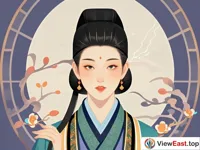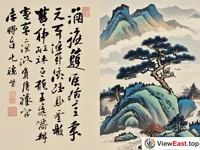







Introduction
Chinese calligraphy and painting art are treasures of Chinese culture, bearing the wisdom and emotions of a thousand years. They are not only forms of art but also a philosophy of life and a spiritual pursuit. The scent of ink through the ages not only signifies the long history of these art forms but also symbolizes their significant place in Chinese culture.
Chinese Calligraphy: The Beauty of Lines
Chinese calligraphy is hailed as "poetry without sound, dance without form." It displays the strength and beauty of lines through the flow of ink and brush. Calligraphy is not just the writing of characters but also an expression of emotions and a display of personality.
he Four Treasures of the Study: Tools of Calligraphy
The four major tools of calligraphy—brush, ink, paper, and inkstone—are known as the "Four Treasures of the Study." Each tool has its unique craftsmanship and cultural connotation. A good brush requires careful material selection and production; a superior ink needs a complex refining process; a high-quality rice paper requires multiple processing steps; a fine inkstone requires the craftsman's meticulous carving.
Regular Script, Running Script, Cursive Script: Schools of Calligraphy
Chinese calligraphy has various schools, among which Regular Script, Running Script, and Cursive Script are the most famous. Regular Script is known for its neatness and clarity, forming the foundation of learning calligraphy; Running Script adds fluidity to Regular Script, making it more expressive; Cursive Script is even more free and unrestrained, best reflecting the calligrapher's personality and emotions.
Chinese Painting: The Beauty of Mood
Chinese painting is known for its unique mood and profound connotation. It is not only a depiction of natural scenery but also a reflection of the painter's inner world.
Landscape Painting: An Ode to Nature
Landscape painting is an important genre in Chinese painting. It displays the magnificence of nature and the painter's emotions through the depiction of mountains, rivers, and clouds. Landscape painting is not just a reproduction of natural scenery but also an understanding and praise of the spirit of nature.
Flower-and-Bird Painting: A Tribute to Life
Flower-and-Bird painting, through the depiction of flowers, birds, and other natural life, shows the vitality of life and the painter's emotions. Flower-and-Bird painting is not just a reproduction of natural life but also a praise and tribute to the beauty of life.
Figure Painting: Emotional Exchange
Figure painting, through the depiction of human images, shows the character, emotions, and spiritual outlook of the figures. Figure painting is not just a reproduction of human images but also an exploration and expression of the inner world of the figures.
Conclusion
Chinese calligraphy and painting art are important components of Chinese culture. They display the beauty of lines and mood through the flow of ink and the use of colors. Delving deeper into these art forms not only allows us to better understand Chinese culture but also helps us find tranquility and poetry in the busy modern life.
Exploring Chinese calligraphy, we can learn how to express emotions and personality through ink and brush; studying Chinese painting, we can learn how to depict mood and emotions through colors and lines. The essence of these art forms is not only an enjoyment of beauty but also nourishment for the soul.